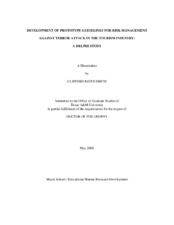| dc.description.abstract | The purpose of the study was to gather strategies and factors from tourism security professionals from which terrorism risk management policies can be developed. This study utilized the Delphi method in order to provide structure for the group process. Twelve tourism security experts made up the panel completing three rounds of questionnaires via the email based Delphi technique. This research identified fifty-four strategies to reduce the propensity of terror attack at a tourism venue. Those strategies were divided into four levels of priority based on criticality and feasibility. The fifty-four strategies were grouped into nine subordinate categories. The subordinate categories were related to Training, Communications/ Liaison, Planning/ Assessment, Background Checks, ID Badges/ Secure Entrance, Specialty Security Units, Architectural Design, Media Cooperation, and Technology Based strategies. Alongside the strategies are a collection of comments by the experts regarding strengths, weaknesses, and any barriers to implementation pertaining to the individual strategy. Tourism risk managers, security personnel, and insurance underwriters can all use the results in reducing the opportunity for a terrorist attack at a tourism venue. Major research findings from this study included: 1. The strategy receiving the highest criticality ranking over all other strategies involves training first responders on their role in circumventing the success of terrorists. 2. The subordinate category Communication/ Liaison contains the largest number of strategies indicating the significance of this category among experts. 3. The subordinate category of Specialty Security Units contains the second highest number of strategies indicating the importance of the topic among experts. 4. All of the technology based strategies fell into the lowest priority level. Based on the findings of this study, researcher recommendations include: 1. The guidelines developed in this study should be used by operators of tourism venues to make the best use of limited resources. 2. National or international conferences should be established to further discuss these issues. 3. A greater number of communications mediums should be established to facilitate the exchange of ideas and experiences between affected professionals. 4. Insurance providers should use this information to establish validated guidelines so that, if prospective clients adhered to the recommendations, a reduction in premiums could be offered. 5. Other entities may benefit from this study, such as public school systems, the energy production industry, hospital systems, and pipeline systems. | en |


